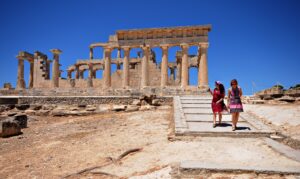Aegina Geography & History
Aegina lies almost at the center of the Saronic gulf, to the south of Piraeus and Salamina and is surrounded by a large number of small uninhabited islands.
Its soil is fertile and there are several plains, low hills, small bays and fine beaches.
The climate is mild and suitable for the growing of pistachio trees and vines.
Aegina History
The island has been inhabited from Neolithic times, when the earliest settlements appeared about in 3.000 BC at Kolona and Agia Marina.
The Dorians later settled here, bringing with them the cult of Zeus Hellanios.
In the 6th c. Aegina acquired a large merchant fleet and became a leading naval power.
Her ships carried the produces of the island all over the Mediterranean, along with Aeginitean pottery made by local craftsmen.
Aegina Geography & History
Aegina played an important role during the Persian Wars with her fleet, but after this the naval power of Athens became predominant and in 456 BC the island was made subject to the Athenians.
In the Peloponnesian war it aligned itself with the Spartans against their opponents, Athens.
After this, Aegina was conquered at various times by the Spartans, Thebans, Macedonians and Romans and was then sold to Attalos, king of Pergamos.
Aegina History
During the Byzantine period, it was frequently raided and plundered by pirates and the inhabitants withdrew into the interior of the island, built the Byzantine capital, Paleochora, and fortified it with a medieval castle. It was latter captured by the Venetians and finally, by the Turks, in 1718.
The inhabitants of Aegina took part in the liberation struggle of 1821 against the Turks and for a brief period, after the war of Independence, it was the temporary capital of the newly founded Greek State, and headquarters of Kapodistrias, the first governor of free Greece.


